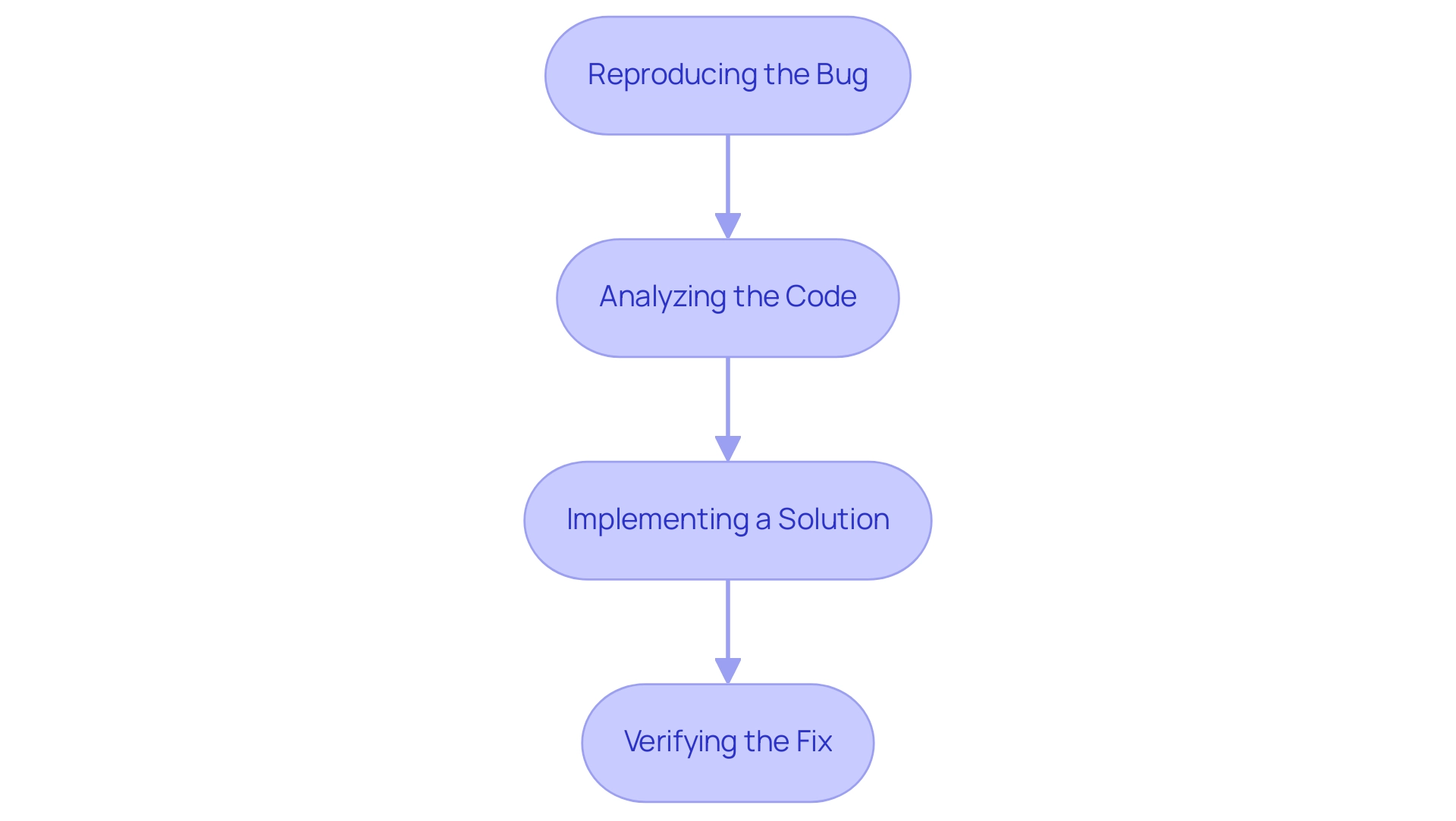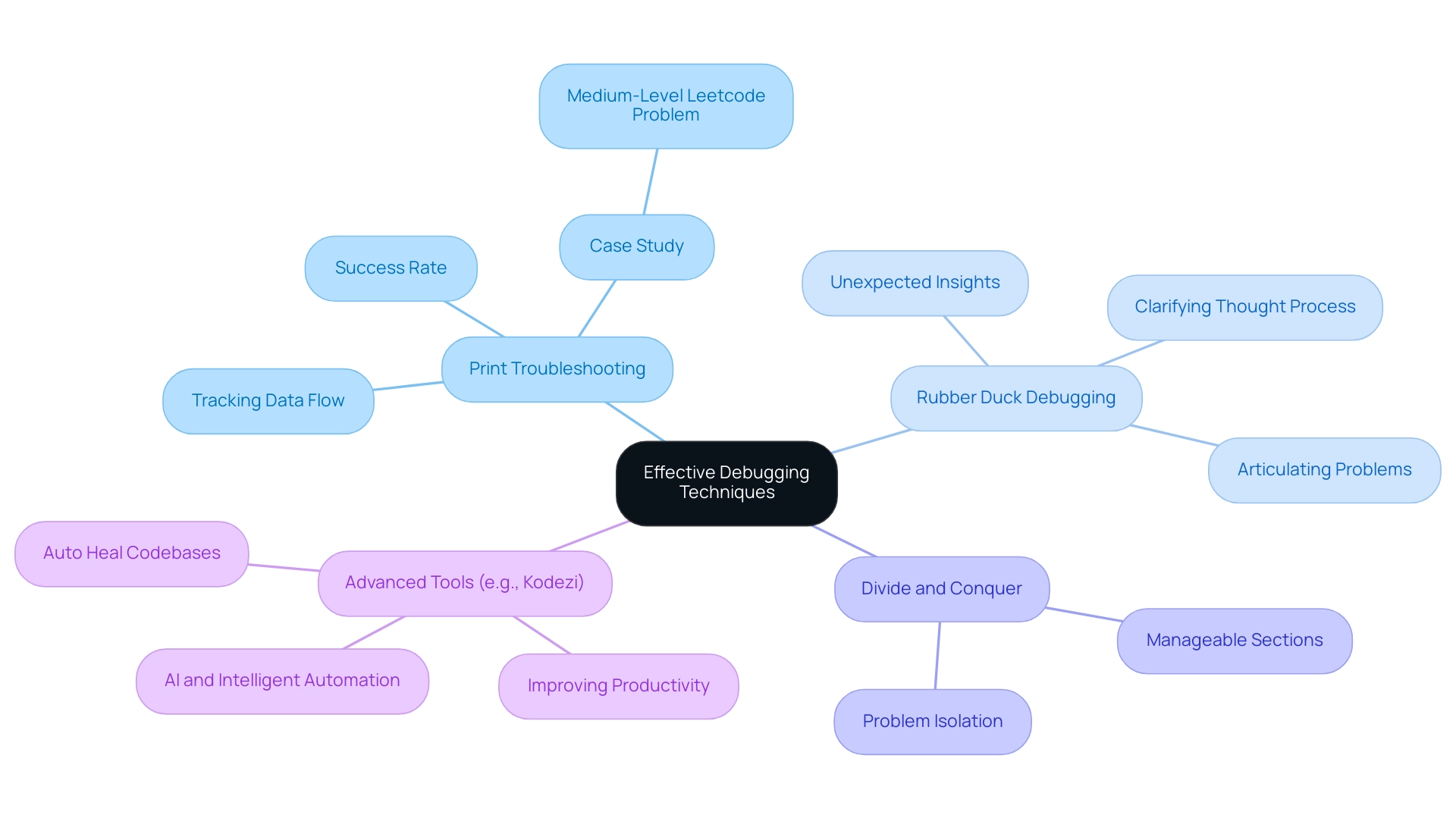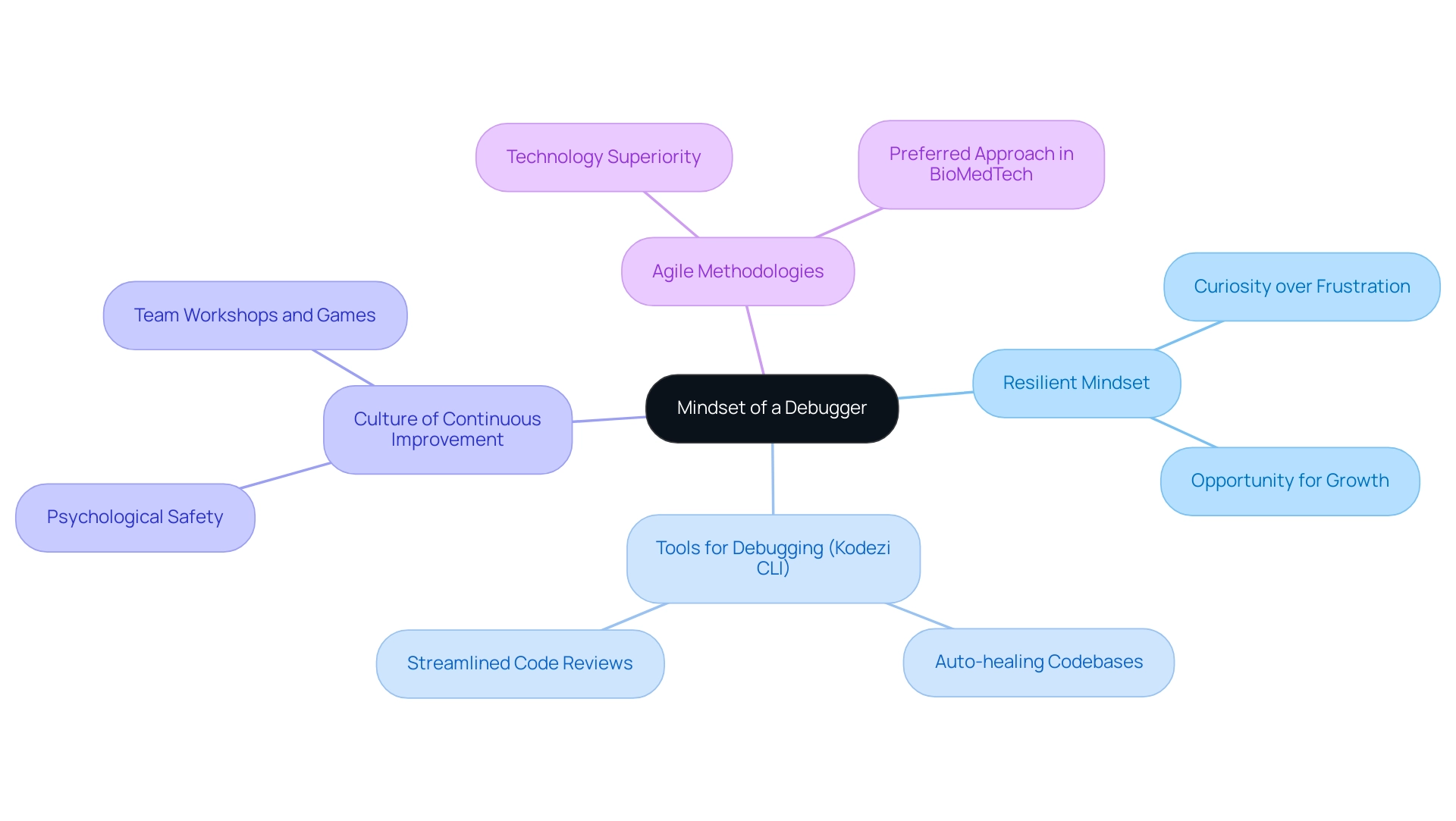Overview
Best practices for debugging methods include systematic approaches such as reproducing bugs, analyzing code, implementing solutions, and verifying fixes, which are essential for effective software development. The article supports this by outlining various effective techniques, such as print troubleshooting and rubber duck debugging, and emphasizes the importance of utilizing tools like Kodezi CLI to enhance efficiency and accuracy in the debugging process.
Introduction
In the fast-evolving landscape of software development, debugging emerges as a pivotal process that can make or break a project. As developers grapple with the complexities of code, the ability to swiftly identify and resolve issues is paramount. With the right tools and techniques, teams can transform the often-daunting task of debugging into a streamlined, efficient process.
Enter Kodezi CLI, a powerful ally that not only automates bug fixes but also enhances code quality and security compliance. By embracing innovative debugging strategies and leveraging advanced tools, developers can significantly reduce roadblocks, ensure robust software solutions, and ultimately elevate their productivity.
This article delves into the essential stages of debugging, effective techniques, and the tools that can empower developers to tackle challenges with confidence and precision.
Understanding Debugging: The Essential Process for Developers
The essential procedure in software development involves debugging methods for identifying, isolating, and resolving issues within the program. This essential skill is crucial for developers, as unresolved bugs can lead to inefficient code, performance degradation, and potential security vulnerabilities. Statistics reveal that 20% of software development teams encounter significant roadblocks during debugging and testing phases, underscoring the need for effective debugging methods.
With tools like CLI, B2B engineering teams can autonomously enhance their codebases and resolve bugs before they reach production. The CLI facilitates rapid issue resolution by instantly identifying and addressing codebase problems, providing detailed explanations and insights into what went wrong and how issues were resolved. This guarantees adherence to the latest security best practices and programming standards, enabling teams to improve quality and optimize performance swiftly.
Additionally, Kodezi CLI is positioned as the B2B Swiss Army Knife for Engineering Teams, offering a versatile solution for various troubleshooting needs. The debugging methods generally encompass several key stages:
- Reproducing the bug to observe its behavior
- Analyzing the code to uncover the root cause
- Implementing a solution
- Verifying that the fix resolves the issue without introducing new complications
Comprehending these stages enables creators to address challenges more systematically.
Jacek Materna, CTO at Assembla, emphasizes the significance of proactive measures, stating,
One of the best ways we deal with bugs is empowering each of our individual programmers to avoid bugs in the first place.
This highlights the value of fostering individual accountability within development teams to reduce bugs from the outset.
Practical uses of debugging methods can be observed in the case of Functionize’s continuous testing solutions, which allow programmers to implement CI/CD models effectively. Their machine learning engine offers a no-code test maintenance and repair system, alleviating the challenges of test maintenance and allowing for earlier defect detection. This capability significantly reduces the costs associated with late-stage defects in the software development lifecycle.
Furthermore, prioritizing bug fixes based on customer impact is vital for resource allocation, ensuring that development teams focus on the most critical issues that affect users. By mastering these troubleshooting stages and utilizing tools like Kodezi, which also provides a quick start demo for prompt engagement, programmers enhance their efficiency and contribute to more robust software solutions.

Effective Debugging Techniques: Strategies for Success
Utilizing a range of effective debugging methods can significantly simplify the troubleshooting process. Print troubleshooting stands out as a powerful method, where programmers insert print statements throughout the code to monitor variable values and track program flow. This straightforward approach often quickly uncovers the source of a bug, allowing for rapid resolution.
In fact, statistics indicate that developers utilizing print techniques have a markedly higher success rate in identifying issues—especially when compared to more complex methods. For instance, a case study involving a medium-level Leetcode problem demonstrated the effectiveness of print analysis. In this scenario, the model initially generated faulty scripts but, through the iterative process of adding print statements to track data flow, it identified inconsistencies between the test case and logs, ultimately correcting the scripts to pass all test cases.
Another innovative technique is rubber duck debugging, which involves articulating your programming and its associated problems to an inanimate object, such as a rubber duck. As Anil Hemrajani, CTO at iSavvix, aptly notes:
If an administrator reconfigures the default location of these files, you can waste time trying to locate the files; and if you don’t have permission to access the files, you are out of luck until the problem is fixed.
This practice often leads to unexpected insights and clarifies the thought process, ultimately resulting in a deeper understanding of the programming.
Additionally, employing a divide and conquer strategy can enhance problem isolation. By breaking down the code into smaller, manageable sections, programmers can more effectively pinpoint where issues arise. Incorporating debugging methods such as CLI, the multifunctional tool for programmers, allows teams to Auto Heal codebases in seconds, changing how developers tackle error correction.
Kodezi enhances traditional techniques by reducing the time spent on pull requests and improving productivity. The evolution of error correction techniques is also influenced by advancements in AI and Intelligent Automation, where tools like KodeziChat facilitate rapid coding question resolution and code issue solving. These innovations not only enhance troubleshooting skills but also accelerate the problem-solving process, allowing for quicker resolutions and improved overall efficiency in software development.

Leveraging Debugging Tools: Enhancing Your Debugging Process
A broad selection of debugging methods, including automated options such as CLI, are available to programmers, greatly improving the troubleshooting process. Kodezi CLI not only auto-heals codebases in seconds but also fixes performance bottlenecks, identifies security issues, and ensures compliance with the latest coding standards. Integrated Development Environments (IDEs) like Visual Studio and IntelliJ IDEA are furnished with robust built-in error-checking capabilities, allowing programmers to establish breakpoints, navigate through code, and examine variable states in real-time, enhancing the workflow.
Moreover, specialized troubleshooting software like GDB for C/C++ and Chrome DevTools for web applications offers robust capabilities for pinpointing issues. Based on recent information, 48.7% of programmers prefer utilizing jQuery, indicating a movement towards tools that streamline coding and troubleshooting. As we look towards 2024, the introduction of innovative debugging methods like Telerik Fiddler—capable of intercepting and analyzing traffic between browsers and servers, and supporting various protocols—underscores the industry's commitment to enhancing debugging efficiency.
This tool not only assists in identifying issues but also helps programmers understand the interactions between their applications and the network, making it invaluable for web development. Additionally, the recent case study on layoffs in the tech industry reveals that while most professionals feel secure in their jobs, there are concerns about job mobility and career progression. This context emphasizes the significance of remaining informed about advanced debugging methods, which can enhance a programmer's skill set and market appeal.
By utilizing these tools, including AI-driven solutions such as KodeziChat for swift coding question resolution, programmers can greatly enhance their troubleshooting precision, resulting in a more dependable and efficient codebase. As Khalid Abuhakmeh, a .NET Developer Advocate, notes, 'The software development industry has, unfortunately, failed thus far with gender diversity, excluding meaningful perspectives from contributing to the creative process.
I hope for a future where we can do better.' This statement highlights the significance of diverse viewpoints in the development process, suggesting that effective debugging tools should be created with input from a wider array of contributors to meet varied needs and enhance overall efficiency.
Overcoming Debugging Challenges: Tips and Solutions
Developers frequently face a range of challenges, including elusive bugs, stringent time constraints, and inadequate documentation. To effectively tackle these issues, a systematic approach using debugging methods is essential. The AI-driven programming tool greatly boosts efficiency by independently examining and rectifying scripts, enabling programmers to concentrate on more intricate problem-solving.
The software not only corrects bugs automatically but also clarifies the specifics of these issues, providing insights that assist in comprehension and education. Thorough documentation of any changes made to the codebase facilitates clarity and aids in knowledge transfer among team members. Employing version control systems allows programmers to return to stable iterations of the software, greatly minimizing the chance of introducing new mistakes.
Furthermore, code reviews play a crucial role in identifying bugs early in the development cycle, thereby enhancing code quality; this tool complements this by automatically fixing bugs before they reach production. Collaboration with peers can provide fresh perspectives on complex problems, often leading to quicker resolutions. Taking regular breaks is also beneficial; stepping away can refresh one’s mental state, resulting in newfound clarity when returning to the task.
Maintaining a calm and patient mindset is crucial for effective problem-solving, enabling programmers to tackle issues with clarity and focus. Notably, according to a report by IBM, "addressing software defects in the early stages of development can save up to 80% of the overall cost." This principle is illustrated by a notable case study involving a tech startup that faced significant disruptions due to a high rate of null values during database insertions.
By implementing strict null checks and restructuring their database schema to enforce mandatory fields, they drastically reduced null occurrences, ensuring smoother operations and increased user satisfaction. By adopting these strategies alongside the platform, developers can navigate common debugging methods more effectively, enhancing both productivity and software quality. This tool is suitable for programmers across all industries, whether they are just getting started, professionals seeking optimization, or enterprises looking to reduce project completion times.
Unlike tools like Copilot, which primarily focus on code completion, Kodezi serves as an autocorrect for code, making it an essential tool for anyone looking to improve their programming efforts.
The Mindset of a Debugger: Learning and Growing from Challenges
Debugging, while often seen as a frustrating endeavor, is fundamentally an opportunity for growth when approached with a resilient mindset. In light of the recent statistic that many developers have experienced burnout over the past year, as noted by Marion Løken, it becomes even more crucial for developers to cultivate curiosity rather than succumb to frustration. Each debugging session should be framed as a chance to uncover insights and enhance their craft using effective debugging methods.
With the CLI, teams can auto-heal codebases in seconds, transforming what could be a tedious task into a more efficient process, ultimately enhancing programming productivity. Kodezi CLI's features, such as its ability to automatically fix common coding errors and streamline code reviews, empower programmers to focus on more critical aspects of their work. Reflecting on mistakes not only aids in understanding what went wrong but also equips individuals with strategies to prevent similar issues in the future.
This culture of continuous improvement is vital; it promotes personal development and technical proficiency, resulting in heightened job satisfaction. As Løken suggests, fostering psychological safety within teams can significantly enhance this process. Her team's structured activities—such as workshops and team-building games—have laid a strong foundation of trust, encouraging open communication and collaboration.
Furthermore, with Agile becoming the preferred approach in the evolving BioMedTech sector, embracing the concept of 'Technology Superiority,' as articulated by software engineer John Fleischli, allows developers to overcome biases towards specific tools or languages. This leads to a more effective problem-solving approach, ultimately enhancing individual productivity and positively contributing to the overall dynamics of software development teams in 2024. Don't miss out on the opportunity to revolutionize your debugging methods—try Kodezi CLI today and experience the difference it can make.

Conclusion
Embracing effective debugging practices is essential for developers aiming to enhance their productivity and deliver high-quality software. By understanding the critical stages of debugging, utilizing innovative techniques, and leveraging powerful tools like Kodezi CLI, developers can navigate the complexities of code with greater ease. Key strategies such as:
- Print debugging
- Rubber duck debugging
- Systematic problem-solving
not only streamline the troubleshooting process but also foster a culture of continuous improvement and learning within development teams.
The role of advanced debugging tools cannot be overstated. Kodezi CLI exemplifies how automation can transform the debugging landscape, allowing teams to rectify issues swiftly while maintaining compliance with security standards and coding best practices. As the software development industry continues to evolve, staying abreast of these tools and techniques will empower developers to tackle challenges head-on, ultimately resulting in more robust and efficient software solutions.
In conclusion, the journey of debugging should be viewed as an opportunity for growth and development. By cultivating a resilient mindset and leveraging resources like Kodezi, developers can not only enhance their technical skills but also contribute to a more collaborative and innovative work environment. Embracing these strategies will lead to improved code quality, reduced time to market, and a more satisfying software development experience.
Frequently Asked Questions
What is the essential procedure in software development regarding debugging?
The essential procedure involves identifying, isolating, and resolving issues within the program through effective debugging methods. This skill is crucial for developers to prevent inefficient code, performance degradation, and security vulnerabilities.
What statistics highlight the challenges faced during debugging in software development?
Statistics reveal that 20% of software development teams encounter significant roadblocks during the debugging and testing phases, emphasizing the need for effective debugging methods.
How does Kodezi CLI assist engineering teams in debugging?
Kodezi CLI allows B2B engineering teams to autonomously enhance their codebases and resolve bugs before they reach production. It facilitates rapid issue resolution by identifying and addressing codebase problems instantly, providing detailed explanations of what went wrong and how to fix it.
What are the key stages involved in debugging methods?
The key stages in debugging methods include: 1. Reproducing the bug to observe its behavior. 2. Analyzing the code to uncover the root cause. 3. Implementing a solution. 4. Verifying that the fix resolves the issue without introducing new complications.
Why is individual accountability important in software development?
Individual accountability is vital as it empowers programmers to avoid bugs from the outset, reducing the number of bugs that need to be addressed later in the development process.
What practical uses of debugging methods are highlighted in the article?
The article discusses Functionize’s continuous testing solutions, which enable programmers to implement CI/CD models effectively, allowing for earlier defect detection and reducing costs associated with late-stage defects in the software development lifecycle.
How can teams prioritize bug fixes effectively?
Teams should prioritize bug fixes based on customer impact to ensure that they focus on the most critical issues affecting users.
What is print troubleshooting, and how effective is it?
Print troubleshooting involves inserting print statements throughout the code to monitor variable values and track program flow. This method has a high success rate in identifying issues quickly, often outperforming more complex debugging methods.
What is rubber duck debugging, and how does it help?
Rubber duck debugging involves explaining programming problems to an inanimate object, like a rubber duck. This practice often leads to unexpected insights and clarifies the thought process, resulting in a deeper understanding of the programming issues.
What is the divide and conquer strategy in debugging?
The divide and conquer strategy involves breaking down the code into smaller, manageable sections to effectively pinpoint where issues arise, enhancing problem isolation.
How does Kodezi enhance traditional debugging techniques?
Kodezi enhances traditional techniques by reducing the time spent on pull requests and improving productivity, allowing teams to resolve issues more efficiently.
How are advancements in AI influencing debugging methods?
Advancements in AI and Intelligent Automation, such as tools like KodeziChat, facilitate rapid resolution of coding questions and code issues, enhancing troubleshooting skills and accelerating the problem-solving process in software development.




